The Economics and Statistics Division maintains archives of previous publications for accountability purposes, but makes no updates to keep these documents current with the latest data revisions from Statistics Canada. As a result, information in older documents may not be accurate. Please exercise caution when referring to older documents. For the latest information and historical data, please contact the individual listed to the right.
<--- Return to Archive
For additional information relating to this article, please contact:
February 08, 2019LABOUR MARKET TRENDS - JANUARY 2019 Nova Scotia's seasonally adjusted employment increased by 6,100 to 465,100 in January 2019. This marks the seventh consecutive month of employment growth and the highest level of employment in the 43-year history of the labour force survey.
Compared to December, Nova Scotia’s labour force increased by 5,400 to 499,200 in January. Unemployment declined by 600, and with employment increasing along with the labour force, the net result was a 0.1 percentage point decrease in the seasonally adjusted unemployment rate to 6.9 per cent in January. This is the lowest unemployment rate for Nova Scotia in the labour force survey, slightly below the previous low set in April of last year.
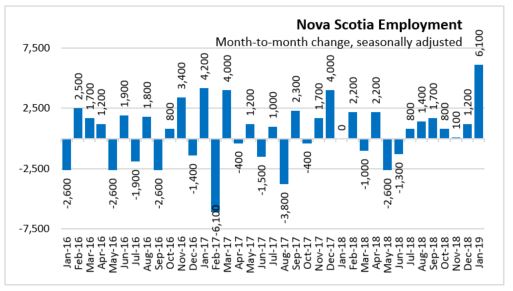
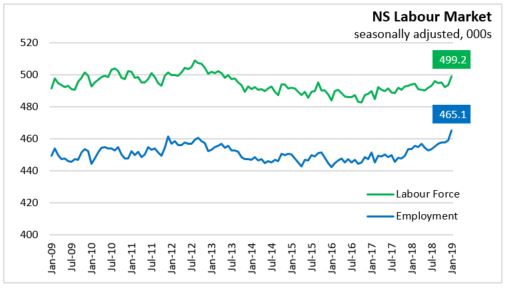
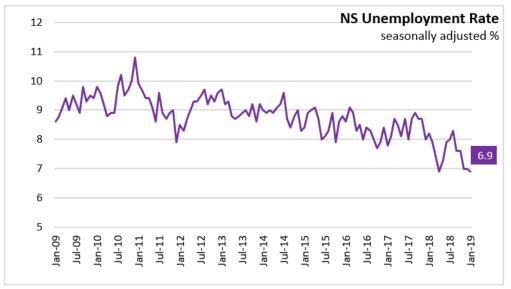
In January, the increase in employment was due to a gain in full-time employment (3,600) as well as in part-time employment (2,400). Full-time employment has once again reached an all time high at 381,600. Note: Changes in part-time and full-time employment can include the net impacts of changing hours of work within the same position.
Compared with January 2018, the labour force has increased by 5,300 while employment is up 11,600. The year-over-year increase in employment includes a rise of 10,100 in full time employment and an increase of 1,400 in part time employment. The unemployment rate was 1.3 percentage points lower in January 2019 than it was in January 2018.
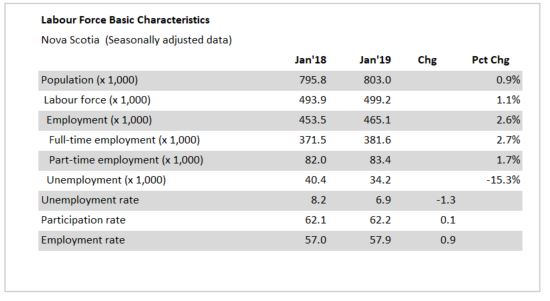
Age Cohorts
In January 2019, the monthly unemployment rate for the 15-24 age cohort dropped 0.6 percentage points to 13.4 per cent. The unemployment rate for the 25-54 year old age cohort declined 0.3 percentage points to 5.7 per cent, and for those aged 55 years and older, the unemployment rate increased 0.3 percentage points to 5.6 per cent.

Comparing January 2019 to January 2018, the youth cohort (aged 15-24) saw a decrease in population (-300) along with increases of 4,000 in labour force and 6,800 in employment. With the number of unemployed declining as a proportion of the labour force, the unemployment rate for 15-24-year olds decreased 4.9 percentage points over the last year to 13.4 per cent in January 2019.
Within the 25-54 age cohort, the population in January 2019 was 1,400 higher than it was in January 2018. With employment among core aged workers rose by 500 while the labour force dropped by 1,500 compared with January 2018. As a result, the unemployment rate declined by 0.7 percentage points over last year to 5.7 per cent in January 2019.
In year over year terms, older workers (55+) reported a population increase of 6,200 in January 2019. The labour force for older workers was up 2,800 and employment increased by 4,100. With employment rising faster than the increase in labour force, there was a decrease in the unemployment rate from 6.9 per cent in January 2018 to 5.6 per cent in January 2019.
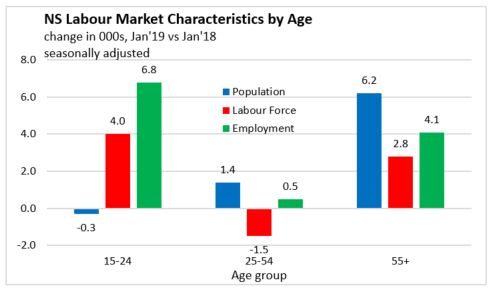
Sectors
Looking at the monthly results by class of worker for January 2019, employment increases for the private sector (5,700) and for the public sector (1,600) offset self employment declines (-1,200). In year over year terms, private sector employment was up 7,800, public sector employment increased 5,700, and self employment declined 1,900.
Among goods-producing sectors, January 2019 saw year over year employment growth concentrated in construction (+1,100) and agriculture (+1,000) offsetting declines manufacturing (-400) and in forestry, fishing, hunting, mining and oil and gas (-100). Services-producing employment increased by 10,300 compared to January 2018. The largest increases come from Trade, accommodation/food sectors, information, culture and recreation, and health care and social assistance. The largest decline came from finance/insurance, public administration, and other services.
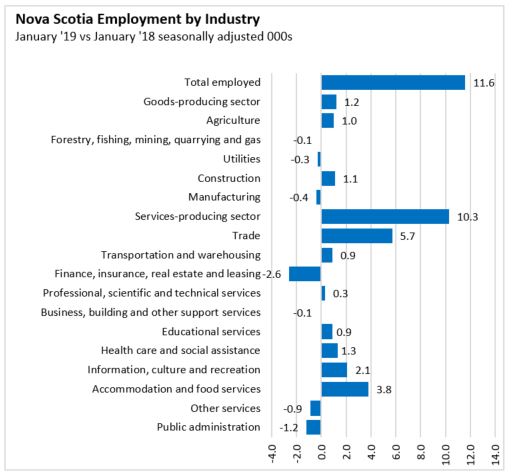
Regions - Year over year (3-month moving average)
Comparing January 2019 against January 2018, unemployment rates fell in all economic regions except Cape Breton. The Southern and Halifax regions both saw employment gains, while all regions except Cape Breton had declines in total unemployment.
The Cape Breton region showed declines in both employment (-1,900) and labour force (-700), and an increase in unemployment (1,200). This put upward pressure on the unemployment rate, which rose from 14.3 per cent in January 2018 to 16.7 per cent in January 2019.
For the North Shore region, the labour force declined by 4,700 and employment declined by 2,600. With labour force falling more quickly than employment, unemployment dropped by 2,200, causing a 2.6 percentage point drop in the unemployment rate from 9.1 per cent to 6.5 per cent.
The Annapolis Valley reported a decline of 2,300 for employment along with a decline of 3,100 for the labour force. Unemployment dropped by 700, and the net result was drop in the average unemployment rate of 0.8 percentage points to 7.3 per cent.
The Southern region saw an increase of 5,700 in employment along with an increase of 5,000 in the labour force. With labour force and employment increasing even faster (reducing unemployment by 800), the unemployment rate was down 2.1 percentage points to 6.5 per cent for January 2019.
Halifax experienced an increase in employment of 10,300 along with an increase in the labour force of 5,900. With unemployment declining by 4,400, there was a drop in the unemployment rate of 2.0 percentage points to 4.5 per cent in Halifax.
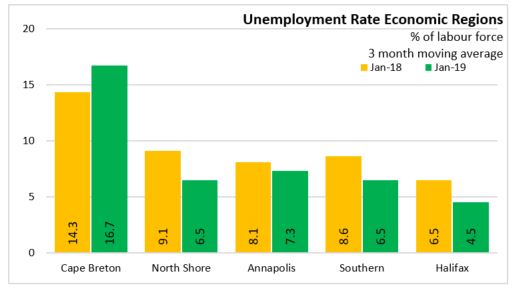
Provincial Comparisons
The Nova Scotia unemployment rate was 6.9 per cent in January 2019, down from 8.2 per cent a year ago. The Canadian unemployment rate was 5.8 per cent, down from 5.9 per cent one year ago. Canada's unemployment rate remains near record lows since the start of the Labour Force Survey.
Compared to the same month one year ago, all provinces except Ontario (+0.1 percentage point) and Quebec (no change) showed declines in the unemployment rate. The lowest unemployment rate among the provinces this month was in British Columbia (4.7 per cent) while the highest was in Newfoundland and Labrador at 11.4 per cent.
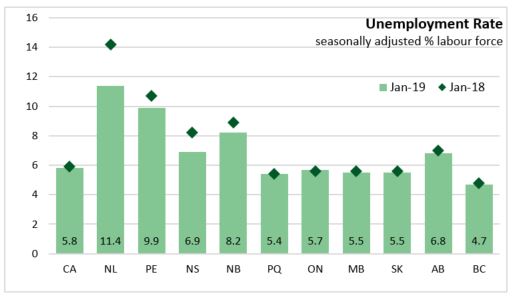
Employment across the country was up in all provinces in January 2019 compared to January 2018, with the largest gains in percentage terms in Newfoundland and Labrador (3.5%) and Nova Scotia (2.6%). The smallest gains were in PEI and Alberta. Nationally, employment was up 1.8 per cent.
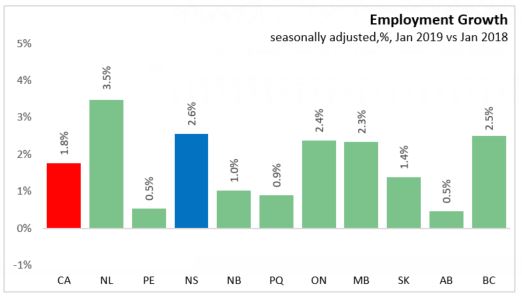
National Comparisons: Cities (Monthly)
The seasonally adjusted unemployment rate for the Halifax Census Metropolitan Area (CMA) in January 2019 was 5.1 per cent (3 month moving average). Guelph, Ontario (1.9 per cent) had the lowest unemployment rate among CMAs, while the highest was in St. John’s (7.4 per cent).

The seasonally adjusted employment rate for the Halifax CMA was 64.3 per cent, up slightly from last month. Saguenay had the lowest employment rate (53.5 per cent), while Guelph had the highest (68.5 per cent).
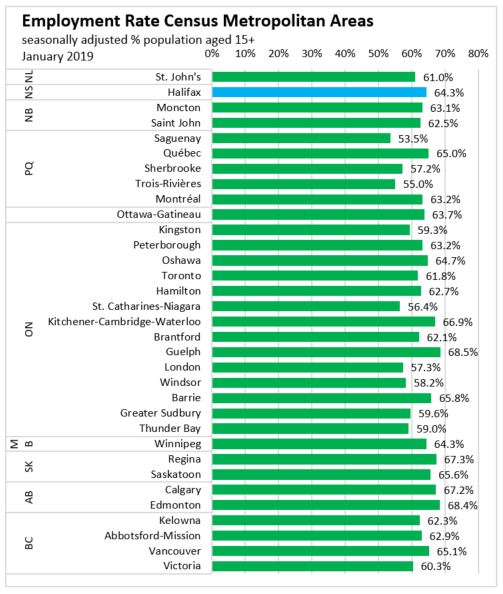
Halifax’s employment (3 month moving average) for January 2019 was up 0.5 per cent compared to the December 2018 result. The largest gain among CMAs was in Brantford, Ontario, where employment rose by 2.2 per cent.


Note: Seasonally adjusted, 3 month average.
With the January 2019 Labour Force Survey release, Statistics Canada has changed the processing systems that is used to impute data of incomplete records of the survey. Statistics Canada notes that for most LFS estimates the difference from the new system will be small, but some areas could be impacted such as part-time employment and employment by firm size. The transition is being monitored and historical revisions of series maybe made in the future. For more details, see Transition of Labour Force Survey Data Processing to the Social Survey Processing Environment (SSPE)
<--- Return to Archive